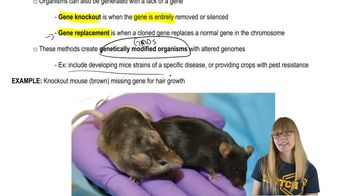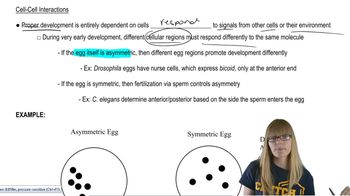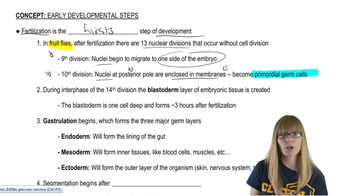Table of contents
- 1. Introduction to Genetics51m
- 2. Mendel's Laws of Inheritance3h 37m
- 3. Extensions to Mendelian Inheritance2h 41m
- 4. Genetic Mapping and Linkage2h 28m
- 5. Genetics of Bacteria and Viruses1h 21m
- 6. Chromosomal Variation1h 48m
- 7. DNA and Chromosome Structure56m
- 8. DNA Replication1h 10m
- 9. Mitosis and Meiosis1h 34m
- 10. Transcription1h 0m
- 11. Translation58m
- 12. Gene Regulation in Prokaryotes1h 19m
- 13. Gene Regulation in Eukaryotes44m
- 14. Genetic Control of Development44m
- 15. Genomes and Genomics1h 50m
- 16. Transposable Elements47m
- 17. Mutation, Repair, and Recombination1h 6m
- 18. Molecular Genetic Tools19m
- 19. Cancer Genetics29m
- 20. Quantitative Genetics1h 26m
- 21. Population Genetics50m
- 22. Evolutionary Genetics29m
14. Genetic Control of Development
Early Developmental Steps
Problem 1a
Textbook Question
In this chapter, we have focused on large-scale as well as the inter- and intracellular events that take place during embryogenesis and the formation of adult structures. In particular, we discussed how the adult body plan is laid down by a cascade of gene expression, and the role of cell–cell communication in development. Based on your knowledge of these topics, answer several fundamental questions:
How did we learn about the levels of gene regulation involved in vulval development in C. elegans?
 Verified step by step guidance
Verified step by step guidance1
<span>Step 1: Understand the model organism - C. elegans is a nematode used extensively in genetic studies due to its simplicity and well-mapped cell lineage.</span>
<span>Step 2: Identify the key genes - Research has identified several key genes involved in vulval development, such as the lin-3, let-23, and let-60 genes, which are part of a signaling pathway.</span>
<span>Step 3: Explore the signaling pathway - The vulval development in C. elegans is regulated by the Epidermal Growth Factor (EGF) signaling pathway, where the LIN-3 protein acts as a signaling molecule.</span>
<span>Step 4: Examine genetic experiments - Genetic experiments, such as gene knockouts and RNA interference, have been used to study the effects of these genes on vulval development.</span>
<span>Step 5: Analyze cell-cell communication - The role of cell-cell communication is crucial, as the anchor cell in C. elegans sends signals to the vulval precursor cells, guiding their development through a cascade of gene expression.</span>
Recommended similar problem, with video answer:
 Verified Solution
Verified SolutionThis video solution was recommended by our tutors as helpful for the problem above
Video duration:
2mPlay a video:
Was this helpful?
Key Concepts
Here are the essential concepts you must grasp in order to answer the question correctly.
Gene Regulation
Gene regulation refers to the mechanisms that control the expression of genes, determining when and how much of a gene product is produced. In the context of development, this regulation is crucial for ensuring that specific genes are activated or silenced at the right times and in the right cells, which is essential for proper embryonic development and the formation of structures.
Recommended video:
Guided course

Review of Regulation
C. elegans as a Model Organism
C. elegans, a small nematode worm, is widely used as a model organism in developmental biology due to its simple anatomy, transparent body, and well-mapped genome. Studies on C. elegans have provided significant insights into genetic pathways and cellular processes, particularly in understanding how gene regulation influences developmental events such as vulval formation.
Recommended video:
Guided course

Transgenic Organisms and Gene Therapy
Cell-Cell Communication
Cell-cell communication is the process by which cells send and receive signals to coordinate their activities during development. In C. elegans, signaling pathways, such as the LIN-3/EGF pathway, play a critical role in vulval development by mediating interactions between cells, influencing gene expression, and determining cell fate decisions.
Recommended video:
Guided course

Cell-cell interactions

 3:46m
3:46mWatch next
Master Drosophilia Development with a bite sized video explanation from Kylia Goodner
Start learningRelated Videos
Related Practice


